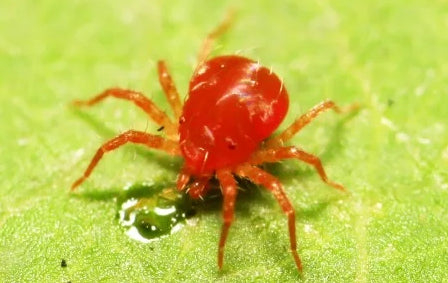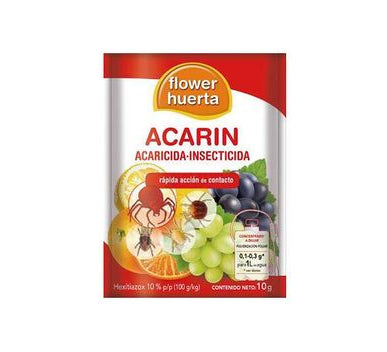Best price on the market

- How to Identify Red Spider Mites
- How to Prevent Red Spider Mites
- 1. Environmental Control
- 2. Regular Cleaning and Maintenance
- 3. Physical Barriers
- 4. Using Companion Plants
- 5. Biological Control
- 6. Constant Review and Monitoring
- Insecticide against red spider
- 1. Precautions and Recommendations
- 2. How to Eliminate Red Spider Naturally
- Care and Recovery of Affected Plants
- Leave a comment
How to remove red spider mites from cannabis plants
The red spider, a tiny but formidable enemy of cannabis plants, is one of thepests and diseases in marijuana . These almost microscopic mites feed voraciously on the cellular fluids of plants, leaving behind a trail of damage and weakness. In cannabis plants, red spider infestation can be especially devastating. These parasites not only compromise the health and vitality of the plants, but can also significantly affect the quality and yield of the crop.
Effective treatment of cannabis plants for red spider mites is crucial. An uncontrolled infestation can lead to a drastic decrease in yield, and even death of the plants. Therefore, it is essential for growers to recognize and combat these mites in time. Using the best insecticide for red spider plants, along with integrated pest management practices, can be the key to preserving the health and vigor of cannabis plants. Implementing a proper treatment for red spider mites not only ensures the survival of the plants, but also guarantees the quality and abundance of the harvest.

How to Identify Red Spider Mites
The first step in the battle against red spiders on cannabis plants is to know how to identify them. Although they are small, these pests can be recognized by distinctive signs if observed carefully. The presence of red spiders on cannabis plants manifests itself in several ways:
- Direct Visibility of Mites : Spider mites are tiny, measuring just 0.5 mm, but can be seen as small red or brown dots, especially on the underside of leaves. A magnifying glass may be helpful in observing them.
- Webbing : A telltale sign of spider mite infestation is the appearance of fine webbing on plants. These webbing is used to protect the mite colony from predators and is often an indicator of a serious infestation.
- Leaf Spots or Blotches : Spider mites feed by piercing leaf cells and sucking out their contents, leaving small whitish or yellowish spots or dots on the leaves. This damage may initially appear insignificant, but can quickly increase as the infestation spreads.
- Leaf Discoloration and Dropping : As the infestation worsens, leaves may turn yellow or bronze and drop prematurely. This is due to significant nutrient loss and damage to plant tissues.
- Compromised Growth : Plants infested with spider mites often show stunted or retarded growth. This is due to the stress and damage caused by the mites' constant feeding.

How to Prevent Red Spider Mites
Preventing spider mite infestation on cannabis plants is a fundamental aspect of maintaining a healthy and productive crop. Implementing proactive and detailed strategies can make a big difference in controlling this pest. Here is a more detailed guide to spider mite prevention and treatment:
Environmental Control
- Maintaining Proper Humidity : Spider mites thrive in dry environments. To prevent their appearance, it is crucial to maintain an optimal humidity level in the growing area. This can be achieved by using humidifiers, placing trays of water near heat sources, or regularly misting the areas around the plants with water. A hygrometer can be an invaluable tool for constantly monitoring humidity levels.
- Temperature Management : These mites reproduce more rapidly in warm temperatures. Keeping your grow space at a moderate to slightly cool temperature can help slow down their life cycle. Using air conditioners, fans, or automated cooling systems can be effective.
Regular Cleaning and Maintenance
- Rigorous Hygiene of the Growing Area : Cleaning is one of the most effective preventative measures. Regularly removing dead leaves and other plant debris reduces the areas where spider mites can hide and breed. Additionally, cleaning and disinfecting tools, containers, and surfaces can prevent the transfer of mites to plants.
- Careful Inspection of New Plants and Materials : Before introducing any new plants or materials into the growing space, it is essential to thoroughly inspect them for signs of spider mites. Even small infestations on new plants can quickly become a larger problem.
Physical Barriers
Installing Screens or Filters : Placing protective screens on windows, doors and other entry points can effectively prevent mites from entering from outside. Additionally, using filters on ventilation systems can block the access of these pests.
Using Companion Plants
Growing Repellent Plants : Some plants emit scents or substances that are natural repellents for spider mites. Growing plants such as garlic, basil, cilantro, or marigold near cannabis plants can create a less attractive environment for these mites.
Biological Control
Introduction of Natural Predators : Natural predators, such as Phytoseiulus persimilis mites, are natural enemies of spider mites. These beneficial organisms can help keep spider mite populations under control without the use of chemicals.
Constant Review and Monitoring
Regular Inspections : Conducting thorough inspections of cannabis plants on a frequent basis is essential to detect any early signs of infestation. Pay particular attention to the undersides of leaves and young shoots, where mites tend to congregate.
Insecticide against red spider
The use of chemical treatments may be necessary in cases of severe red spider infestations on cannabis plants. It is important to use these products safely and effectively, always following the manufacturer's instructions and taking appropriate precautions. Below we will show you the best insecticide for red spider:
- ADYBAC 1001 Total Discharge Insecticide : It is an effective option for intensive treatments. It is used for fumigation in closed spaces and is effective against a variety of pests, including red spiders.
- Miscibloil Insecticide Oil 250ml : This insecticidal oil is useful for gentle and effective control of mites and pests. It is particularly useful for preventive and maintenance applications.
- Neemex Natural Insecticide : Based on neem extract, this insecticide is a more natural and less aggressive option. It is ideal for integrated pest management, offering effective control with less environmental impact.
- Acarin Insecticide 10gr : This product is specific for the control of mites and red spiders. Its specific formulation makes it effective in the management of these pests in particular.
- Fertiberia Total Discharge Insecticide : Suitable for applications in closed spaces, this product offers total control through effective fumigation. It is useful in cases of extensive infestations.
- Spruzit Insecticide : This insecticide combines efficacy with an improved safety profile. It is useful for both active infestations and preventative applications.
- Solabiol Insecticide : This is a broader treatment, effective against a variety of pests. Its regular use can help maintain control over infestations.
Precautions and Recommendations
- Read and Follow Instructions : Before applying any insecticide, it is crucial to read and follow the manufacturer's instructions. This ensures safe and effective use.
- Protective Equipment : Always use personal protective equipment, such as gloves and masks, to avoid exposure to chemicals.
- Ventilation : Ensure the area is well ventilated during and after chemical application.
- Avoid Contact with Flowering Plants : Use caution when applying insecticides to flowering plants to avoid affecting the quality of the final product.
- Product Rotation : To prevent resistance, rotate the use of different types of insecticides.
- Consult an Expert : If you are unsure about which product to use or how to apply it, consult an expert or specialist.
How to Eliminate Red Spider Naturally
When it comes to controlling spider mites on cannabis plants, there are several natural and organic techniques that can be highly effective. These methods focus on eliminating the pest without resorting to chemicals, which is beneficial for both the plant and the environment.
- Increase Humidity : Since spider mites prefer dry environments, increasing humidity can be an effective method of combating them. Spraying plants with water, especially the undersides of leaves, can help dislodge and kill mites. However, it is important to balance this with the need to prevent mold and other moisture-related diseases.
- Manual Control : If the infestation is light, mites and their webs can be removed manually. Using a damp cloth or soft brush can help physically remove mites from plants. This technique requires patience and thoroughness.
- Organic Insecticidal Soap : An organic spider mite insecticidal soap solution can be effective against spider mites. This type of soap can be homemade or purchased, and should be applied directly to the affected areas of the plant. It is important to follow the instructions to avoid damaging the plant.
- Essential Oils and Natural Extracts : Some essential oils, such as neem oil, rosemary oil, and peppermint oil, have been shown to be effective against spider mites. These oils can be diluted in water and sprayed on plants. Additionally, extracts such as garlic or hot pepper can also be helpful.
- Use of Natural Predators : Introducing natural predators such as predatory mites (e.g. Phytoseiulus persimilis) is a very effective form of biological control. These predators specifically feed on spider mites and can be a sustainable long-term solution to controlling the mite population.
- Plant Extracts and Botanical Preparations : Preparations made from certain plants can be toxic to spider mites. For example, extracts of quassia, nettle, and tansy can be used in spray form to control infestations.

Care and Recovery of Affected Plants
After treating a spider mite infestation on cannabis plants, it is crucial to provide specific care to ensure their recovery and promote healthy growth.
- Proper Hydration : After treatment, make sure plants receive enough water. This is vital to help them recover from the stress caused by the infestation and the treatments applied.
- Nutrition Review : Check and adjust your plants' nutrition plan. The infestation may have affected their ability to absorb nutrients, so they may need an additional boost or correction in their feeding.
- Monitoring Plant Health : Conduct regular inspections to assess plant recovery. Pay attention to new growth and the general condition of leaves and stems.
- Environmental Control : Maintain optimal environmental conditions in terms of temperature and humidity. A stable environment helps plants recover more quickly.
- Careful Pruning : If some areas of the plant have been severely damaged, careful pruning may be necessary. Remove severely affected parts to promote healthy new growth.
- Use of Plant Stimulants and Fortifiers : Consider using growth stimulants or fortifiers to help plants recover more quickly. These products can improve plant resistance and speed up recovery.
- Avoid Additional Stress : Minimize any additional stress on the plants during their recovery period. This includes avoiding unnecessary transplants or abrupt changes to their environment.
- Continued Pest Monitoring : Even after treating the infestation, continue to monitor plants for any signs of spider mite reappearance. Continued vigilance is key to preventing future infestations.

Leave a comment